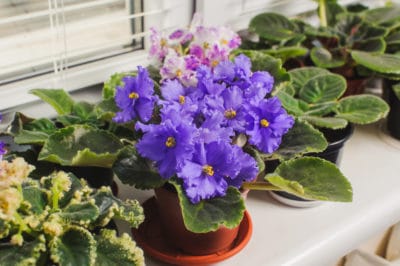Basic Requirements for an African Violet
Bloom takes lots of plant energy. If you haven’t met the basic requirements, your African violet may not bloom. The plants need:
- The right kind of light
- Temperatures between 65°F (18°C) and 75°F (24°C)
- Adequate water
- Humidity of 50 percent
- Proper fertilizer
- Pots of the right size and regular repotting.
Light Leads the Way
Of all an African violet’s needs, adequate light of the right kind is at the top of the list. The plants must have 14 to 16 hours of indirect bright light each day. African violets also require eight hours of darkness to develop florigen, the flowering hormone. They tolerate direct sun in early morning and late evening only. A south- or west-facing window with a translucent blind or shade is ideal.
Soil and Fertilizer
Pasteurized potting soil with a pH of 5.8 to 6.2 (slightly acidic) is best for African violets. Many commercial mixes are available, or you can make your own. Equal amounts of commercial potting soil, peat moss and perlite is one possible blend. Fertilize with water-soluble 14-12-14 NPK organic fertilizer (7-9-5 NPK for miniatures). Most experts recommend fertilizing each time you water.
Watering African Violets
There is no one-rule-fits-all when it comes to watering. The goal is to water often enough to keep the soil just moist. Soggy soil encourages rot and can kill the plant. Check the soil surface every day and water with room temperate water if it seems dry. Use rain water or filtered water rather than tap water. Allow soil to dry between waterings. Self-watering pots may work well but monitor closely.
Humidity for African Violets
In their native habitat, African violets enjoy a humidity of around 70 percent. Few homes have that sort of humidity. You can increase the humidity by misting the plants twice a day with room temperature water. Don’t spray if plants are in direct sun as it may damage leaves. Place pots on shallow trays filled with water-covered pebbles. You can also group plants together to increase humidity.
Pots and Repotting
African violets do better if they don’t have big pots. The rule of thumb is that the plant should be three times the diameter of the pot. Turn the plant upside down to remove it, then place in a new pot with new soil. You should repot at least once and preferably twice a year for best bloom. Water well after repotting.
